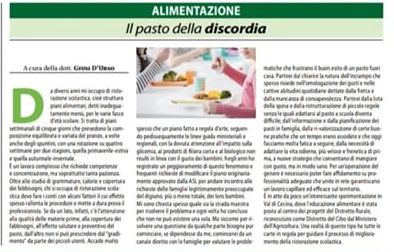 Da diversi anni mi occupo di ristorazione scolastica, cioè strutturo piani alimentari, detti inadeguatamente menù, per le varie fasce d’età scolare. Si tratta di piani settimanali di cinque giorni che prevedono la composizione equilibrata e variata del pranzo, a volte anche degli spuntini, con una rotazione su quattro settimane per due stagioni, quella primaverile – estiva e quella autunnale-invernale. È un lavoro complesso che richiede competenze e concentrazione, ma soprattutto tanta pazienza. Oltre allo studio di grammature, calorie e copertura dei fabbisogni, chi si occupa di ristorazione scolastica deve fare i conti con alcuni fattori il cui effetto spesso rallenta le procedure e mette a dura prova il professionista. Se da un lato, infatti, c’è l’attenzione alla qualità delle materie prime, alla copertura dei fabbisogni, all’effetto salutare e preventivo del pasto, dall’altro non si può prescindere dal “gradimento” da parte dei piccoli utenti. Accade molto spesso che un piano fatto a regola d’arte, seguendo pedissequamente le linee guida ministeriali e regionali, con la dovuta attenzione all’impatto sulla glicemia, ai prodotti di filiera corta e al biologico non risulti in linea con il gusto dei bambini. Negli anni ho registrato un peggioramento di questo fenomeno e frequenti richieste di modificare il piano originariamente approvato dalla ASL per andare incontro alle richieste delle famiglie legittimamente preoccupate del digiuno, più o meno totale, dei loro bambini.
Da diversi anni mi occupo di ristorazione scolastica, cioè strutturo piani alimentari, detti inadeguatamente menù, per le varie fasce d’età scolare. Si tratta di piani settimanali di cinque giorni che prevedono la composizione equilibrata e variata del pranzo, a volte anche degli spuntini, con una rotazione su quattro settimane per due stagioni, quella primaverile – estiva e quella autunnale-invernale. È un lavoro complesso che richiede competenze e concentrazione, ma soprattutto tanta pazienza. Oltre allo studio di grammature, calorie e copertura dei fabbisogni, chi si occupa di ristorazione scolastica deve fare i conti con alcuni fattori il cui effetto spesso rallenta le procedure e mette a dura prova il professionista. Se da un lato, infatti, c’è l’attenzione alla qualità delle materie prime, alla copertura dei fabbisogni, all’effetto salutare e preventivo del pasto, dall’altro non si può prescindere dal “gradimento” da parte dei piccoli utenti. Accade molto spesso che un piano fatto a regola d’arte, seguendo pedissequamente le linee guida ministeriali e regionali, con la dovuta attenzione all’impatto sulla glicemia, ai prodotti di filiera corta e al biologico non risulti in linea con il gusto dei bambini. Negli anni ho registrato un peggioramento di questo fenomeno e frequenti richieste di modificare il piano originariamente approvato dalla ASL per andare incontro alle richieste delle famiglie legittimamente preoccupate del digiuno, più o meno totale, dei loro bambini.
Mi sono chiesta spesso quale sia la strada maestra per risolvere il problema e ogni volta ho concluso che non ne può esistere una sola. Ma siccome per risolvere una questione da qualche parte bisogna pur cominciare, se dipendesse da me, comincerei da un canale diretto con le famiglie per valutare le problematiche che frustrano il buon esito di un pasto fuori casa. Partirei dal chiarire la natura dell’inciampo che spesso risiede nell’omologazione dei gusti e nelle cattive abitudini quotidiane dettate dalla fretta e dalla mancanza di consapevolezza. Partirei dalla lista della spesa e dalla ristrutturazione di piccole regole senza le quali adattarsi al pasto a scuola diventa difficile; dall’informazione e dalla pianificazione dei pasti in famiglia, dalla ri-valorizzazione di certe buone pratiche che un tempo erano assodate e che oggi facciamo molta fatica a seguire; dalla necessità di adattare la vita odierna, più veloce e frenetica di prima, a nuove strategie che consentano di mangiare con gusto, ma in modo sano. Per un’operazione del genere è necessario poter fare affidamento su professionalità adeguate che unite in rete garantiscano un lavoro capillare ed efficace sul territorio.
È in atto da poco un’interessante sperimentazione in Val di Cecina, dove l’educazione alimentare è stata posta al centro dei progetti del Distretto Rurale, riconosciuto come Distretto del Cibo dal Ministero dell’Agricoltura. Una realtà di questo tipo ha tutte le carte in regola per guidare il processo di miglioramento della ristorazione scolastica.
Per Dimensione Agricoltura di marzo 2020
